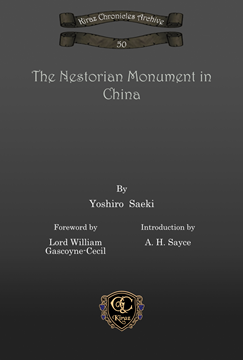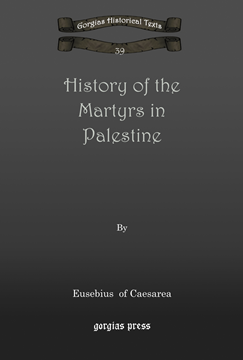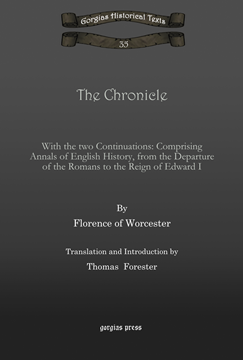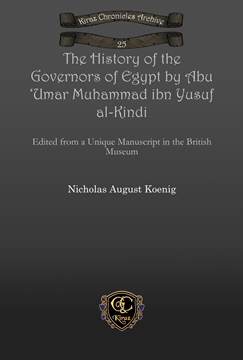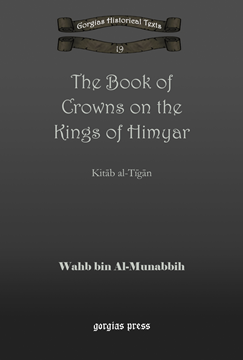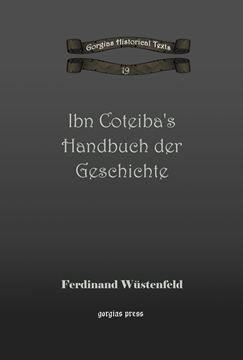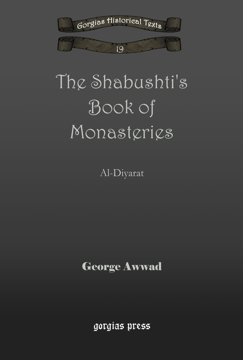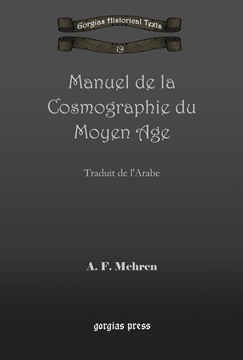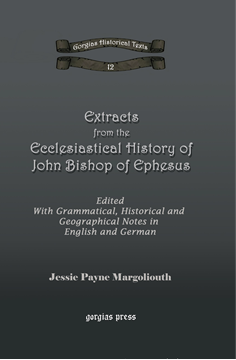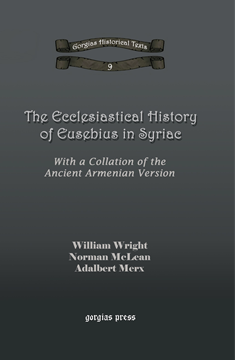Kiraz Chronicles Archive
Kiraz Chronicles Archive makes available rare publications of historical texts from the ancient and medieval worlds. Texts are given in the original language, and, when available, in an English translation.
The Nestorian Monument in China
Series: Kiraz Chronicles Archive 50
ISBN: 978-1-61143-838-3
The text in Chinese and Syriac, with English translation and notes, of the Nestorian Stele, set up in Changan in 781, with a history of the Nestorian Christians of China and their final state as a secret society.
$203.00 (USD) $121.80 (USD)
History of the Martyrs in Palestine
By Eusebius of Caesarea; Edited and Translated by William Cureton
Series: Kiraz Chronicles Archive 39
ISBN: 978-1-61143-355-5
This volume contains William Cureton’s English translation of Eusebius of Caesarea’s History of the Martyrs in Palestine.
$115.00 (USD) $69.00 (USD)
The Chronicle
With the two Continuations: Comprising Annals of English History, from the Departure of the Romans to the Reign of Edward I
By Florence of Worcester; Translation and Introduction by Thomas Forester
Series: Kiraz Chronicles Archive 35
ISBN: 978-1-61719-424-5
The monk Florentius of Worcester compiled several chronicles and other sources, here translated into English. It is an independent source for Anglo-Saxon history, and a contemporary source for the Normans.
$213.00 (USD) $127.80 (USD)
The History of the Governors of Egypt by Abu 'Umar Muhammad ibn Yusuf al-Kindi
Edited from a Unique Manuscript in the British Museum
Series: Kiraz Chronicles Archive 25
ISBN: 978-1-59333-766-7
Published for the first time in this book is the History of the Governors of Egypt by Abu Umar Muhammad ibn Yusuf al-Kindi (d. 870). Edited from a single manuscript by Nicholas Koenig, this study is as close as possible to a critical edition when only one manuscript survives.
$102.00 (USD) $61.20 (USD)
The Book of Crowns on the Kings of Himyar
Kitāb al-Tīgān
Series: Kiraz Chronicles Archive 19
ISBN: 978-1-59333-515-1
The Book of Crowns on the Kings of Himyar, or Kitāb al-Tīgān as it is known in its original Arabic title, is a pre-Islamic collection rich with lore and myth by Wahb ibn al-Munabbih.
$130.00 (USD) $78.00 (USD)
Ibn Coteiba's Handbuch der Geschichte
Series: Kiraz Chronicles Archive 29
ISBN: 978-1-59333-949-4
An early example of Islamic history, the Kitab al-ma'arif (“Book of Knowledge”) of ibn Qutayba (ibn Coteiba) has a prominent place. Born in Kufa, in present-day Iraq, ibn Qutayba was a teacher in Baghdad and he was among the first formal historians. This particular work ambitiously covers topics from the beginning of creation and facts about the period before the appearance of Islam (jahiliyya) to the names of the companions of the prophet Mohammed, famous jurists and masters of the oral tradition associated with the prophet (hadith). Presented here in the original Arabic, along with an introduction by Wüstenfeld, this early manual of history is sure to be of interest to anyone considering Islamic outlooks from the ninth century.
$174.00 (USD) $104.40 (USD)
The Shabushti's Book of Monasteries
Al-Diyarat
By George Awwad
Series: Kiraz Chronicles Archive 19
ISBN: 978-1-59333-535-9
The venerable work of Abu al-Hasan Ali al-Shabushti (d. c. 1000), “The Book of Monasteries,” has come to hold an acclaimed status among scholars of early Arabic Christianity. Thoroughly annotated and cross-referenced, this Arabic edition by George Awwad is more than simply a catalogue of monasteries, it is a view into the culture of early Christianity as it developed in Iraq, Syria, Egypt, and Arabia.
$224.00 (USD) $134.40 (USD)
The Conquest of Syria
Bibliotheca Indica
Series: Kiraz Chronicles Archive 19
ISBN: 978-1-59333-913-5
A representative of the Arabic genre known as “futuh reports,” The Conquest of Syria remains an important historical source although it is now recognized not to be the work of Abu Abdullah Muhammad Ibn Omar Ibn Waqid al-Aslami (called al-Waqidi). This Arabic document, part history, part romantic reconstruction of the past, is one of the main sources narrating the Muslim conquest of Syria. A window into the world of early Muslim self-perception, these documents are a valuable historical source in the sense of being period pieces. Here the Arabic text is presented along with the partial notes and comments of W. Nassau Lees, a noted writer on Eastern culture.
$289.00 (USD) $173.40 (USD)
The History of Mar Jab-Alaha and Rabban Sauma
Histoire de Mar Jab-Alaha, Patriarche, et de Raban Sauma
By Paul Bedjan
Series: Kiraz Chronicles Archive 14
ISBN: 978-1-59333-418-5
This books gives the Syriac text of the account of Yaballaha III, Church of the East Patriarch, and his vicar Bar Sauma, the Mongol Ambassador to the Frankish courts at the end of the thirteenth century.
$231.00 (USD) $138.60 (USD)
Manuel de la Cosmographie du Moyen Age
Traduit de l'Arabe
By A. F. Mehren
Series: Kiraz Chronicles Archive 22
ISBN: 978-1-59333-588-5
A fine example of Arabic science, Shams ed-Din abu-Abdullah Muhammad al-Dimashqi’s Cosmography has almost been forgotten by the Western world. Translated into French by A. F. Mehren, this important historical text will now be widely available.
$197.00 (USD) $118.20 (USD)
The History of Yaballaha III and of His Vicar Bar Sauma
Series: Kiraz Chronicles Archive 13
ISBN: 1-59333-414-1
This book gives an introduction and an annotated English translation of the Syriac account of Yaballaha III, Church of the East Patriarch, and his vicar Bar Sauma, the Mongol Ambassador to the Frankish courts at the end of the thirteenth century. The translation is based on Bedjan’s 1895 edition of the Syriac text (also available from Gorgias Press). In addition to the translation, a survey of the Mongols and their relation to the West is given, as well as a brief history of the "Nestorian" Church.
$107.00 (USD) $64.20 (USD)
Extracts from the Ecclesiastical History of John Bishop of Ephesus
Series: Kiraz Chronicles Archive 12
ISBN: 1-59333-015-4
Composed in three parts, the book chronicles a critical period in the Syriac Orthodox Church, and represents the greatest literary work by the author. It includes grammatical, historical, and geographical notes in English and German.
$115.00 (USD) $69.00 (USD)
The Ecclesiastical History of Eusebius in Syriac
Series: Kiraz Chronicles Archive 9
ISBN: 1-59333-041-3
The Ecclesiastical History of Eusebius of Caesarea, who flourished in the fourth century, has long been considered a landmark in Christian historiography. Written originally in Greek, a Syriac translation appeared during or shortly after the lifetime of the author.
$191.00 (USD) $114.60 (USD)
The Chronicle of Joshua the Stylite
Series: Kiraz Chronicles Archive 8
ISBN: 1-59333-014-6
This standard edition of the Chronicle, composed in AD 507, is considered one of the most valuable authorities for the period with which it deals. The manuscript from which the text is derived is a palimpsest copied between 907 and 944.
$133.00 (USD) $79.80 (USD)
The History of Alexander the Great
Series: Kiraz Chronicles Archive 3
ISBN: 1-59333-011-1
This is a Syriac edition, with English translation, of the folk-lore and legends connected to Alexander the Great. This ancient text represents a Greek text that is much older than any other known version.
$252.00 (USD) $151.20 (USD)

